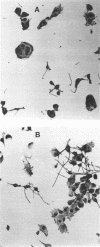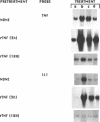Abstract
We have previously demonstrated that the hyphal form of Candida albicans (H-Candida), but not the yeast form (Y-Candida), acts as a macrophage-stimulating agent. The early response (1 to 3 h) of the macrophage cell line ANA-1 to H-Candida results in enhanced tumor necrosis factor (TNF) transcription and production. Here we show that when coincubation times are prolonged (3 to 24 h), Y-Candida also exhibits stimulatory properties. This phenomenon has been ascribed to the occurrence of the dimorphic transition, as demonstrated by microscopic evaluation of the cultures and by experiments in which both killed Y-Candida and the agerminative strain C. albicans PCA-2 failed to induce cytokine production. TNF produced in response to H-Candida acts as an autocrine and paracrine signal controlling the macrophage secretory response to C. albicans. In fact, addition of anti-TNF polyclonal antibodies to the coculture of ANA-1 macrophages and H-Candida results in a marked and time-dependent decrease of TNF transcript levels. Moreover, pretreatment of macrophages with recombinant TNF for 3 h enhances TNF and induces interleukin-1 production in response to both forms of Candida, while pretreatment for 18 h renders macrophages refractory to any stimuli. Interestingly, the kinetics of interleukin-1 transcription and secretion in response to H-Candida are delayed with respect to those of TNF. Overall, these data indicate that TNF, produced by macrophages in response to H-Candida, regulates its own production as well as that of other soluble factors, thus suggesting that this cytokine plays multiple roles in the immune mechanisms involved in Candida infection.
Full text
PDF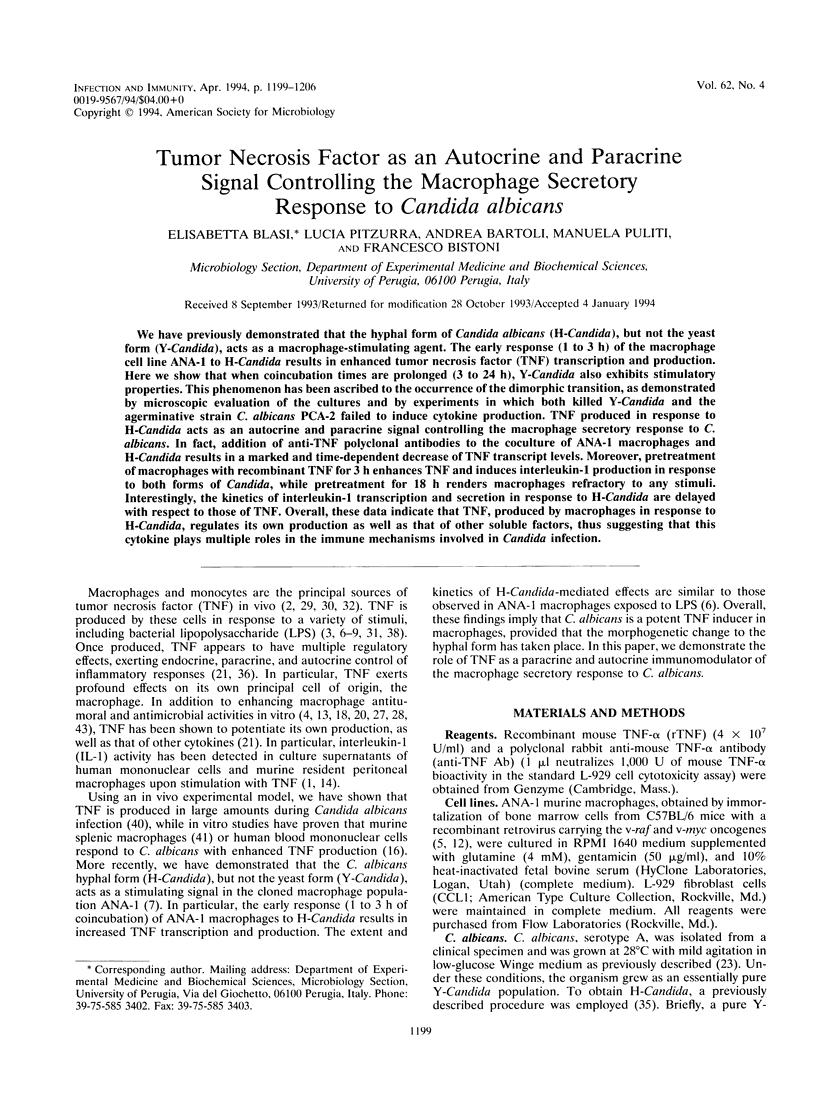
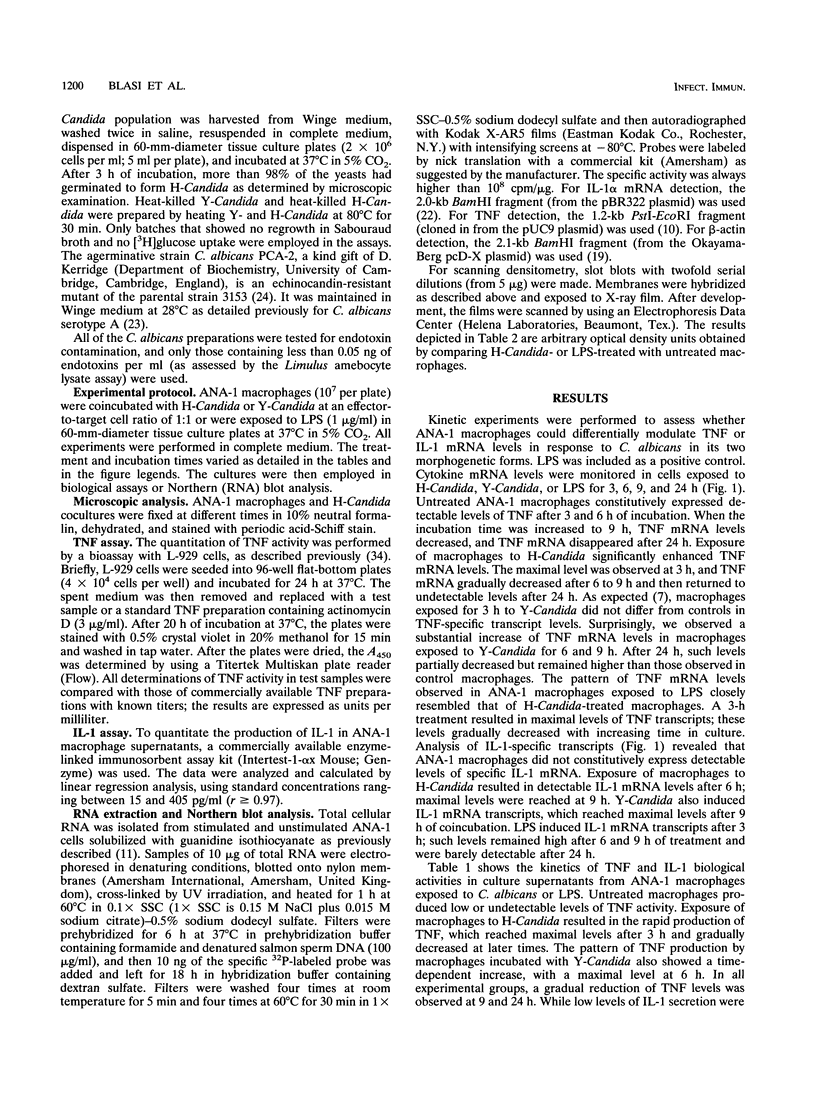
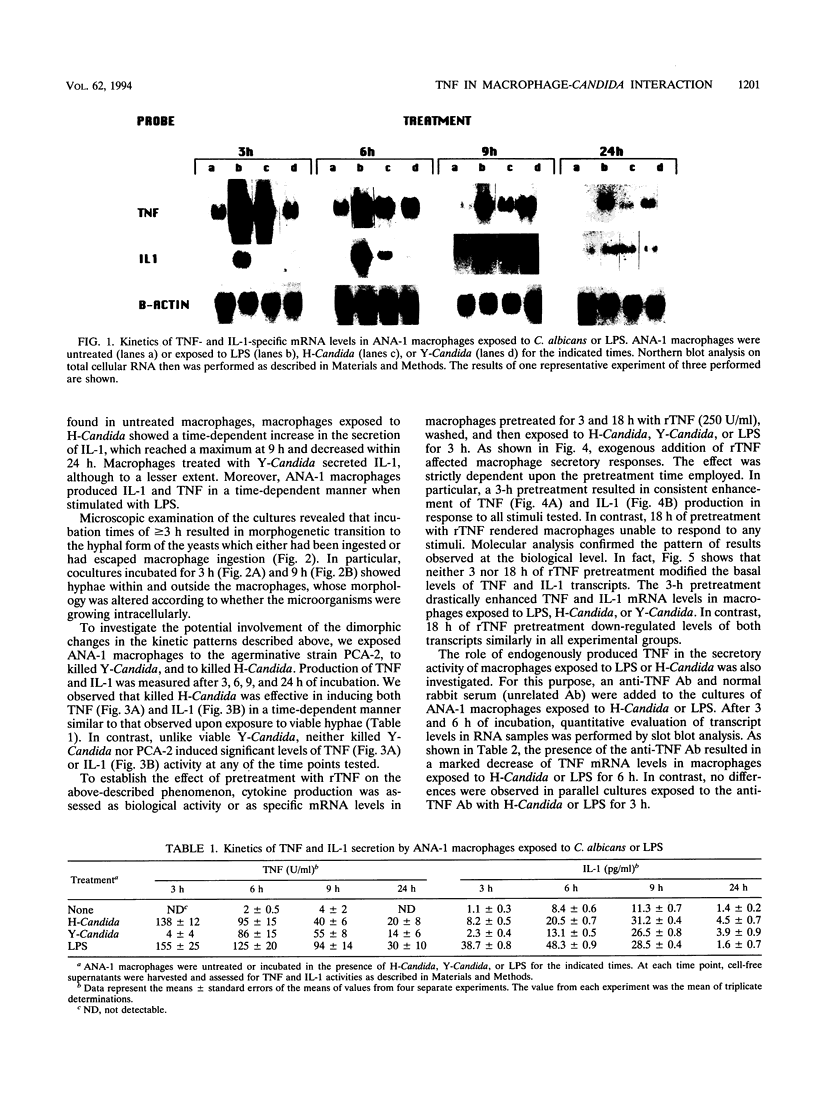
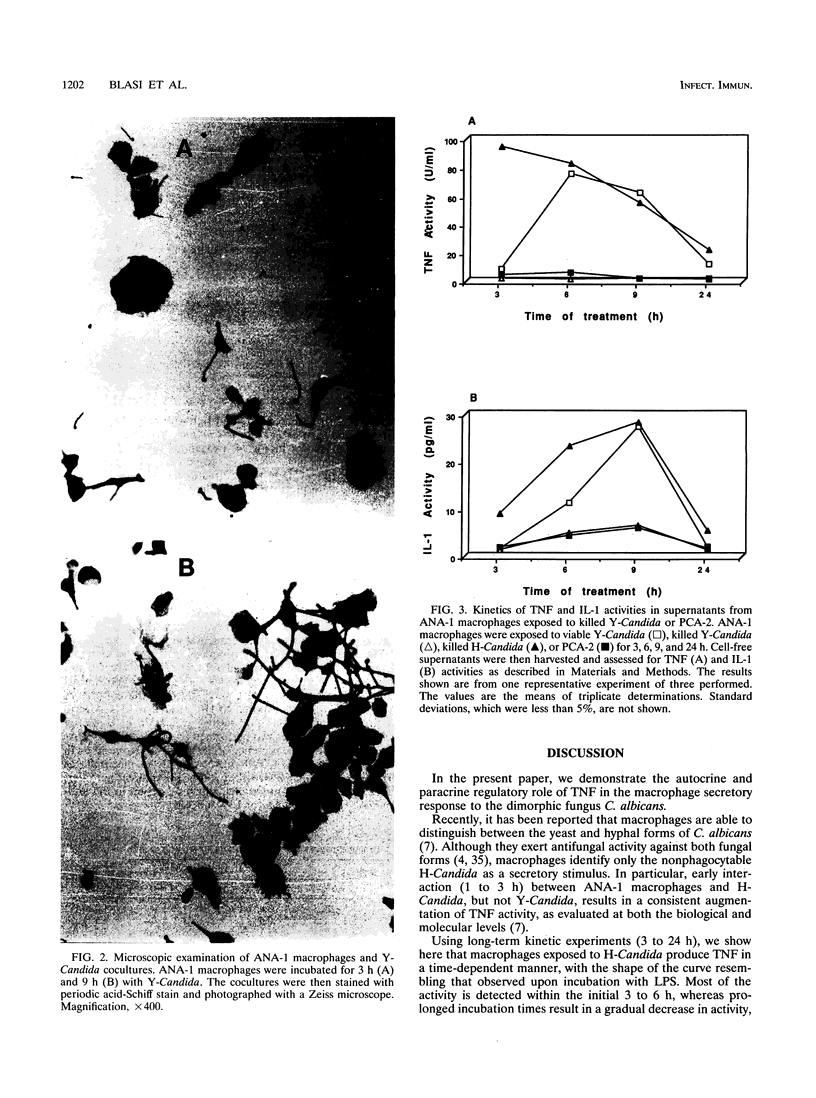
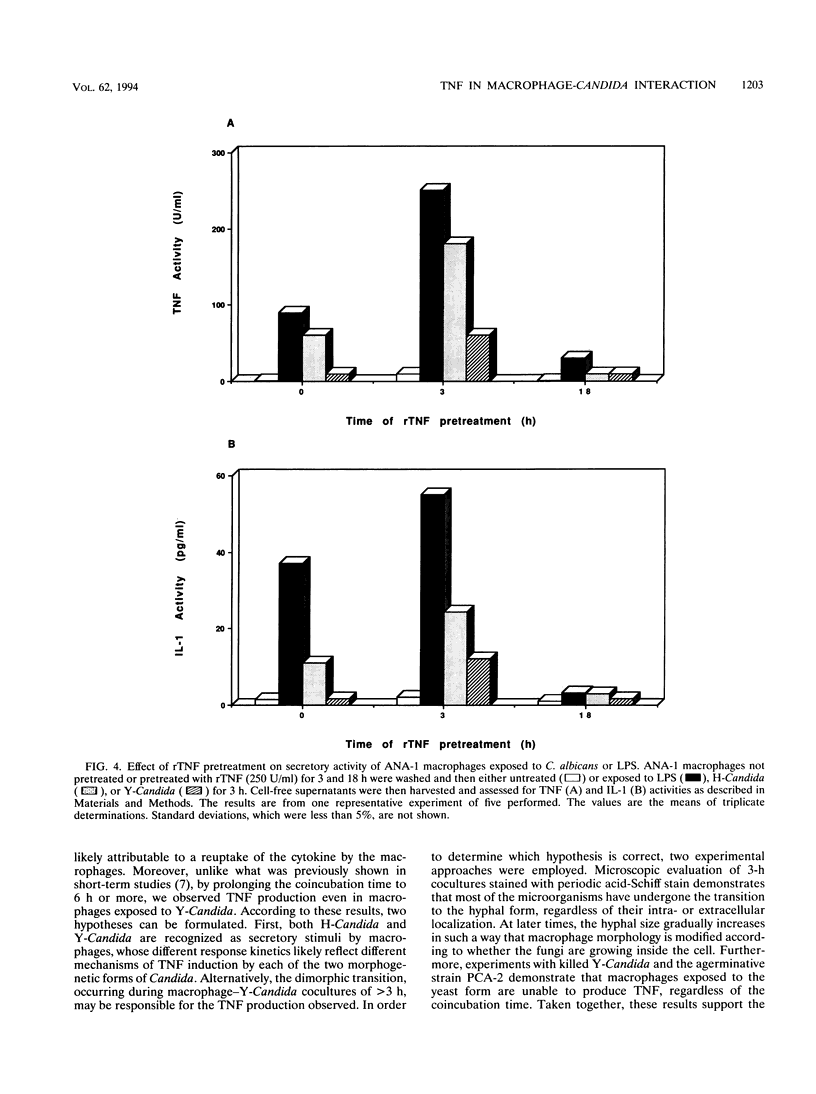
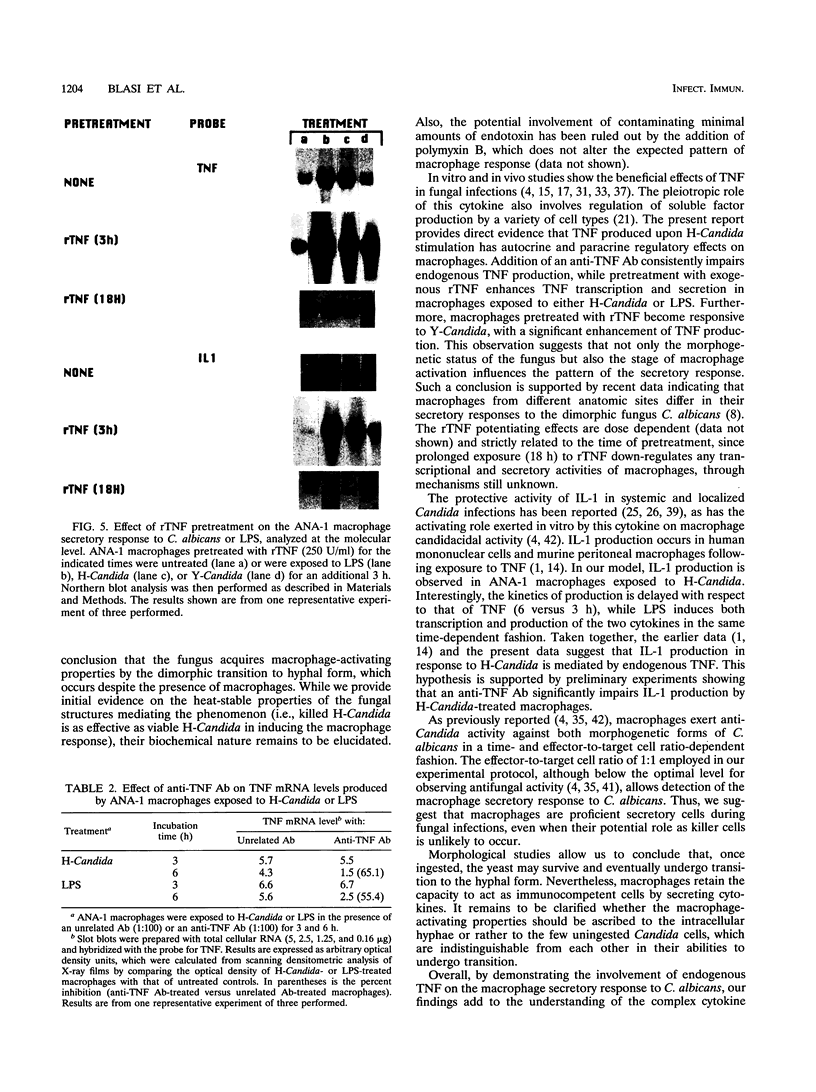
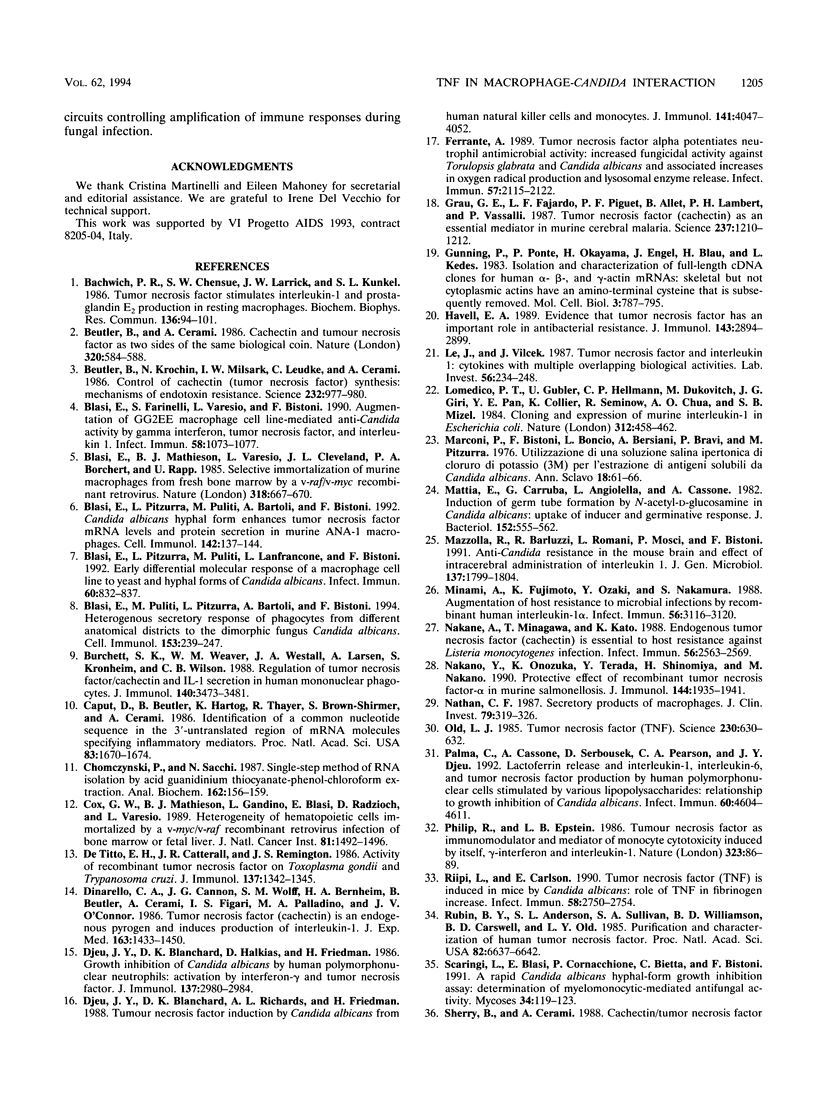
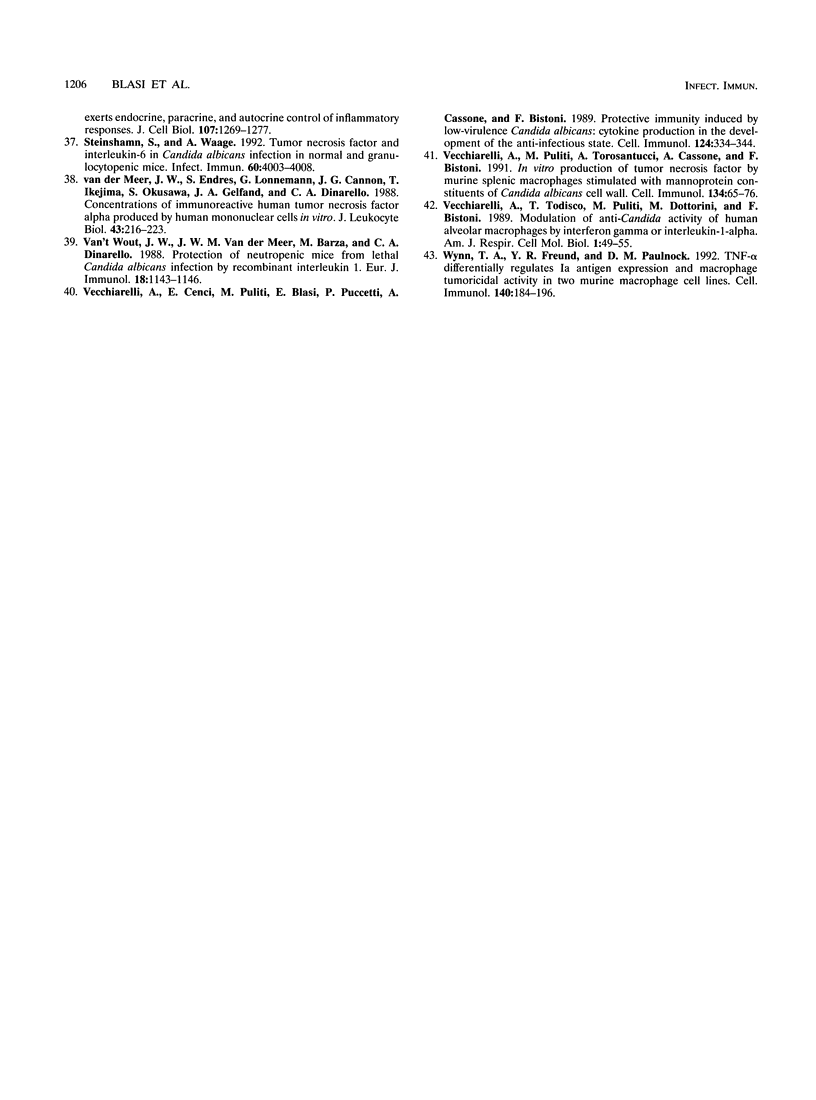
Images in this article
Selected References
These references are in PubMed. This may not be the complete list of references from this article.
- Bachwich P. R., Chensue S. W., Larrick J. W., Kunkel S. L. Tumor necrosis factor stimulates interleukin-1 and prostaglandin E2 production in resting macrophages. Biochem Biophys Res Commun. 1986 Apr 14;136(1):94–101. doi: 10.1016/0006-291x(86)90881-8. [DOI] [PubMed] [Google Scholar]
- Beutler B., Cerami A. Cachectin and tumour necrosis factor as two sides of the same biological coin. Nature. 1986 Apr 17;320(6063):584–588. doi: 10.1038/320584a0. [DOI] [PubMed] [Google Scholar]
- Beutler B., Krochin N., Milsark I. W., Luedke C., Cerami A. Control of cachectin (tumor necrosis factor) synthesis: mechanisms of endotoxin resistance. Science. 1986 May 23;232(4753):977–980. doi: 10.1126/science.3754653. [DOI] [PubMed] [Google Scholar]
- Blasi E., Farinelli S., Varesio L., Bistoni F. Augmentation of GG2EE macrophage cell line-mediated anti-Candida activity by gamma interferon, tumor necrosis factor, and interleukin-1. Infect Immun. 1990 Apr;58(4):1073–1077. doi: 10.1128/iai.58.4.1073-1077.1990. [DOI] [PMC free article] [PubMed] [Google Scholar]
- Blasi E., Mathieson B. J., Varesio L., Cleveland J. L., Borchert P. A., Rapp U. R. Selective immortalization of murine macrophages from fresh bone marrow by a raf/myc recombinant murine retrovirus. Nature. 1985 Dec 19;318(6047):667–670. doi: 10.1038/318667a0. [DOI] [PubMed] [Google Scholar]
- Blasi E., Pitzurra L., Puliti M., Bartoli A., Bistoni F. Candida albicans hyphal form enhances tumor necrosis factor mRNA levels and protein secretion in murine ANA-1 macrophages. Cell Immunol. 1992 Jun;142(1):137–144. doi: 10.1016/0008-8749(92)90275-t. [DOI] [PubMed] [Google Scholar]
- Blasi E., Pitzurra L., Puliti M., Lanfrancone L., Bistoni F. Early differential molecular response of a macrophage cell line to yeast and hyphal forms of Candida albicans. Infect Immun. 1992 Mar;60(3):832–837. doi: 10.1128/iai.60.3.832-837.1992. [DOI] [PMC free article] [PubMed] [Google Scholar]
- Blasi E., Puliti M., Pitzurra L., Bartoli A., Bistoni F. Heterogeneous secretory response of phagocytes from different anatomical districts to the dimorphic fungus Candida albicans. Cell Immunol. 1994 Jan;153(1):239–247. doi: 10.1006/cimm.1994.1021. [DOI] [PubMed] [Google Scholar]
- Burchett S. K., Weaver W. M., Westall J. A., Larsen A., Kronheim S., Wilson C. B. Regulation of tumor necrosis factor/cachectin and IL-1 secretion in human mononuclear phagocytes. J Immunol. 1988 May 15;140(10):3473–3481. [PubMed] [Google Scholar]
- Caput D., Beutler B., Hartog K., Thayer R., Brown-Shimer S., Cerami A. Identification of a common nucleotide sequence in the 3'-untranslated region of mRNA molecules specifying inflammatory mediators. Proc Natl Acad Sci U S A. 1986 Mar;83(6):1670–1674. doi: 10.1073/pnas.83.6.1670. [DOI] [PMC free article] [PubMed] [Google Scholar]
- Chomczynski P., Sacchi N. Single-step method of RNA isolation by acid guanidinium thiocyanate-phenol-chloroform extraction. Anal Biochem. 1987 Apr;162(1):156–159. doi: 10.1006/abio.1987.9999. [DOI] [PubMed] [Google Scholar]
- Cox G. W., Mathieson B. J., Gandino L., Blasi E., Radzioch D., Varesio L. Heterogeneity of hematopoietic cells immortalized by v-myc/v-raf recombinant retrovirus infection of bone marrow or fetal liver. J Natl Cancer Inst. 1989 Oct 4;81(19):1492–1496. doi: 10.1093/jnci/81.19.1492. [DOI] [PubMed] [Google Scholar]
- De Titto E. H., Catterall J. R., Remington J. S. Activity of recombinant tumor necrosis factor on Toxoplasma gondii and Trypanosoma cruzi. J Immunol. 1986 Aug 15;137(4):1342–1345. [PubMed] [Google Scholar]
- Dinarello C. A., Cannon J. G., Wolff S. M., Bernheim H. A., Beutler B., Cerami A., Figari I. S., Palladino M. A., Jr, O'Connor J. V. Tumor necrosis factor (cachectin) is an endogenous pyrogen and induces production of interleukin 1. J Exp Med. 1986 Jun 1;163(6):1433–1450. doi: 10.1084/jem.163.6.1433. [DOI] [PMC free article] [PubMed] [Google Scholar]
- Djeu J. Y., Blanchard D. K., Halkias D., Friedman H. Growth inhibition of Candida albicans by human polymorphonuclear neutrophils: activation by interferon-gamma and tumor necrosis factor. J Immunol. 1986 Nov 1;137(9):2980–2984. [PubMed] [Google Scholar]
- Djeu J. Y., Blanchard D. K., Richards A. L., Friedman H. Tumor necrosis factor induction by Candida albicans from human natural killer cells and monocytes. J Immunol. 1988 Dec 1;141(11):4047–4052. [PubMed] [Google Scholar]
- Ferrante A. Tumor necrosis factor alpha potentiates neutrophil antimicrobial activity: increased fungicidal activity against Torulopsis glabrata and Candida albicans and associated increases in oxygen radical production and lysosomal enzyme release. Infect Immun. 1989 Jul;57(7):2115–2122. doi: 10.1128/iai.57.7.2115-2122.1989. [DOI] [PMC free article] [PubMed] [Google Scholar]
- Grau G. E., Fajardo L. F., Piguet P. F., Allet B., Lambert P. H., Vassalli P. Tumor necrosis factor (cachectin) as an essential mediator in murine cerebral malaria. Science. 1987 Sep 4;237(4819):1210–1212. doi: 10.1126/science.3306918. [DOI] [PubMed] [Google Scholar]
- Gunning P., Ponte P., Okayama H., Engel J., Blau H., Kedes L. Isolation and characterization of full-length cDNA clones for human alpha-, beta-, and gamma-actin mRNAs: skeletal but not cytoplasmic actins have an amino-terminal cysteine that is subsequently removed. Mol Cell Biol. 1983 May;3(5):787–795. doi: 10.1128/mcb.3.5.787. [DOI] [PMC free article] [PubMed] [Google Scholar]
- Havell E. A. Evidence that tumor necrosis factor has an important role in antibacterial resistance. J Immunol. 1989 Nov 1;143(9):2894–2899. [PubMed] [Google Scholar]
- Le J., Vilcek J. Tumor necrosis factor and interleukin 1: cytokines with multiple overlapping biological activities. Lab Invest. 1987 Mar;56(3):234–248. [PubMed] [Google Scholar]
- Lomedico P. T., Gubler U., Hellmann C. P., Dukovich M., Giri J. G., Pan Y. C., Collier K., Semionow R., Chua A. O., Mizel S. B. Cloning and expression of murine interleukin-1 cDNA in Escherichia coli. 1984 Nov 29-Dec 5Nature. 312(5993):458–462. doi: 10.1038/312458a0. [DOI] [PubMed] [Google Scholar]
- Marconi P., Bistoni F., Boncio L., Bersiani A., Bravi P., Pitzurra M. Utilizzazione di soluzione salina ipertonica di cloruro di potassio (3M KC1) per l'estrazione di antigeni solubili da Candia albicans. Ann Sclavo. 1976 Jan-Feb;18(1):61–66. [PubMed] [Google Scholar]
- Mattia E., Carruba G., Angiolella L., Cassone A. Induction of germ tube formation by N-acetyl-D-glucosamine in Candida albicans: uptake of inducer and germinative response. J Bacteriol. 1982 Nov;152(2):555–562. doi: 10.1128/jb.152.2.555-562.1982. [DOI] [PMC free article] [PubMed] [Google Scholar]
- Mazzolla R., Barluzzi R., Romani L., Mosci P., Bistoni F. Anti-Candida resistance in the mouse brain and effect of intracerebral administration of interleukin 1. J Gen Microbiol. 1991 Aug;137(8):1799–1804. doi: 10.1099/00221287-137-8-1799. [DOI] [PubMed] [Google Scholar]
- Minami A., Fujimoto K., Ozaki Y., Nakamura S. Augmentation of host resistance to microbial infections by recombinant human interleukin-1 alpha. Infect Immun. 1988 Dec;56(12):3116–3120. doi: 10.1128/iai.56.12.3116-3120.1988. [DOI] [PMC free article] [PubMed] [Google Scholar]
- Nakane A., Minagawa T., Kato K. Endogenous tumor necrosis factor (cachectin) is essential to host resistance against Listeria monocytogenes infection. Infect Immun. 1988 Oct;56(10):2563–2569. doi: 10.1128/iai.56.10.2563-2569.1988. [DOI] [PMC free article] [PubMed] [Google Scholar]
- Nakano Y., Onozuka K., Terada Y., Shinomiya H., Nakano M. Protective effect of recombinant tumor necrosis factor-alpha in murine salmonellosis. J Immunol. 1990 Mar 1;144(5):1935–1941. [PubMed] [Google Scholar]
- Nathan C. F. Secretory products of macrophages. J Clin Invest. 1987 Feb;79(2):319–326. doi: 10.1172/JCI112815. [DOI] [PMC free article] [PubMed] [Google Scholar]
- Old L. J. Tumor necrosis factor (TNF). Science. 1985 Nov 8;230(4726):630–632. doi: 10.1126/science.2413547. [DOI] [PubMed] [Google Scholar]
- Palma C., Cassone A., Serbousek D., Pearson C. A., Djeu J. Y. Lactoferrin release and interleukin-1, interleukin-6, and tumor necrosis factor production by human polymorphonuclear cells stimulated by various lipopolysaccharides: relationship to growth inhibition of Candida albicans. Infect Immun. 1992 Nov;60(11):4604–4611. doi: 10.1128/iai.60.11.4604-4611.1992. [DOI] [PMC free article] [PubMed] [Google Scholar]
- Philip R., Epstein L. B. Tumour necrosis factor as immunomodulator and mediator of monocyte cytotoxicity induced by itself, gamma-interferon and interleukin-1. Nature. 1986 Sep 4;323(6083):86–89. doi: 10.1038/323086a0. [DOI] [PubMed] [Google Scholar]
- Riipi L., Carlson E. Tumor necrosis factor (TNF) is induced in mice by Candida albicans: role of TNF in fibrinogen increase. Infect Immun. 1990 Sep;58(9):2750–2754. doi: 10.1128/iai.58.9.2750-2754.1990. [DOI] [PMC free article] [PubMed] [Google Scholar]
- Rubin B. Y., Anderson S. L., Sullivan S. A., Williamson B. D., Carswell E. A., Old L. J. Purification and characterization of a human tumor necrosis factor from the LuKII cell line. Proc Natl Acad Sci U S A. 1985 Oct;82(19):6637–6641. doi: 10.1073/pnas.82.19.6637. [DOI] [PMC free article] [PubMed] [Google Scholar]
- Scaringi L., Blasi E., Cornacchione P., Bietta C., Bistoni F. A rapid Candida albicans hyphal-form growth inhibition assay: determination of myelomonocytic-mediated antifungal activity. Mycoses. 1991 Mar-Apr;34(3-4):119–123. doi: 10.1111/j.1439-0507.1991.tb00631.x. [DOI] [PubMed] [Google Scholar]
- Steinshamn S., Waage A. Tumor necrosis factor and interleukin-6 in Candida albicans infection in normal and granulocytopenic mice. Infect Immun. 1992 Oct;60(10):4003–4008. doi: 10.1128/iai.60.10.4003-4008.1992. [DOI] [PMC free article] [PubMed] [Google Scholar]
- Van't Wout J. W., Van der Meer J. W., Barza M., Dinarello C. A. Protection of neutropenic mice from lethal Candida albicans infection by recombinant interleukin 1. Eur J Immunol. 1988 Jul;18(7):1143–1146. doi: 10.1002/eji.1830180728. [DOI] [PubMed] [Google Scholar]
- Vecchiarelli A., Cenci E., Puliti M., Blasi E., Puccetti P., Cassone A., Bistoni F. Protective immunity induced by low-virulence Candida albicans: cytokine production in the development of the anti-infectious state. Cell Immunol. 1989 Dec;124(2):334–344. doi: 10.1016/0008-8749(89)90135-4. [DOI] [PubMed] [Google Scholar]
- Vecchiarelli A., Puliti M., Torosantucci A., Cassone A., Bistoni F. In vitro production of tumor necrosis factor by murine splenic macrophages stimulated with mannoprotein constituents of Candida albicans cell wall. Cell Immunol. 1991 Apr 15;134(1):65–76. doi: 10.1016/0008-8749(91)90331-5. [DOI] [PubMed] [Google Scholar]
- Vecchiarelli A., Todisco T., Puliti M., Dottorini M., Bistoni F. Modulation of anti-Candida activity of human alveolar macrophages by interferon-gamma or interleukin-1-alpha. Am J Respir Cell Mol Biol. 1989 Jul;1(1):49–55. doi: 10.1165/ajrcmb/1.1.49. [DOI] [PubMed] [Google Scholar]
- Wynn T. A., Freund Y. R., Paulnock D. M. TNF-alpha differentially regulates Ia antigen expression and macrophage tumoricidal activity in two murine macrophage cell lines. Cell Immunol. 1992 Mar;140(1):184–196. doi: 10.1016/0008-8749(92)90186-s. [DOI] [PubMed] [Google Scholar]
- van der Meer J. W., Endres S., Lonnemann G., Cannon J. G., Ikejima T., Okusawa S., Gelfand J. A., Dinarello C. A. Concentrations of immunoreactive human tumor necrosis factor alpha produced by human mononuclear cells in vitro. J Leukoc Biol. 1988 Mar;43(3):216–223. doi: 10.1002/jlb.43.3.216. [DOI] [PubMed] [Google Scholar]




